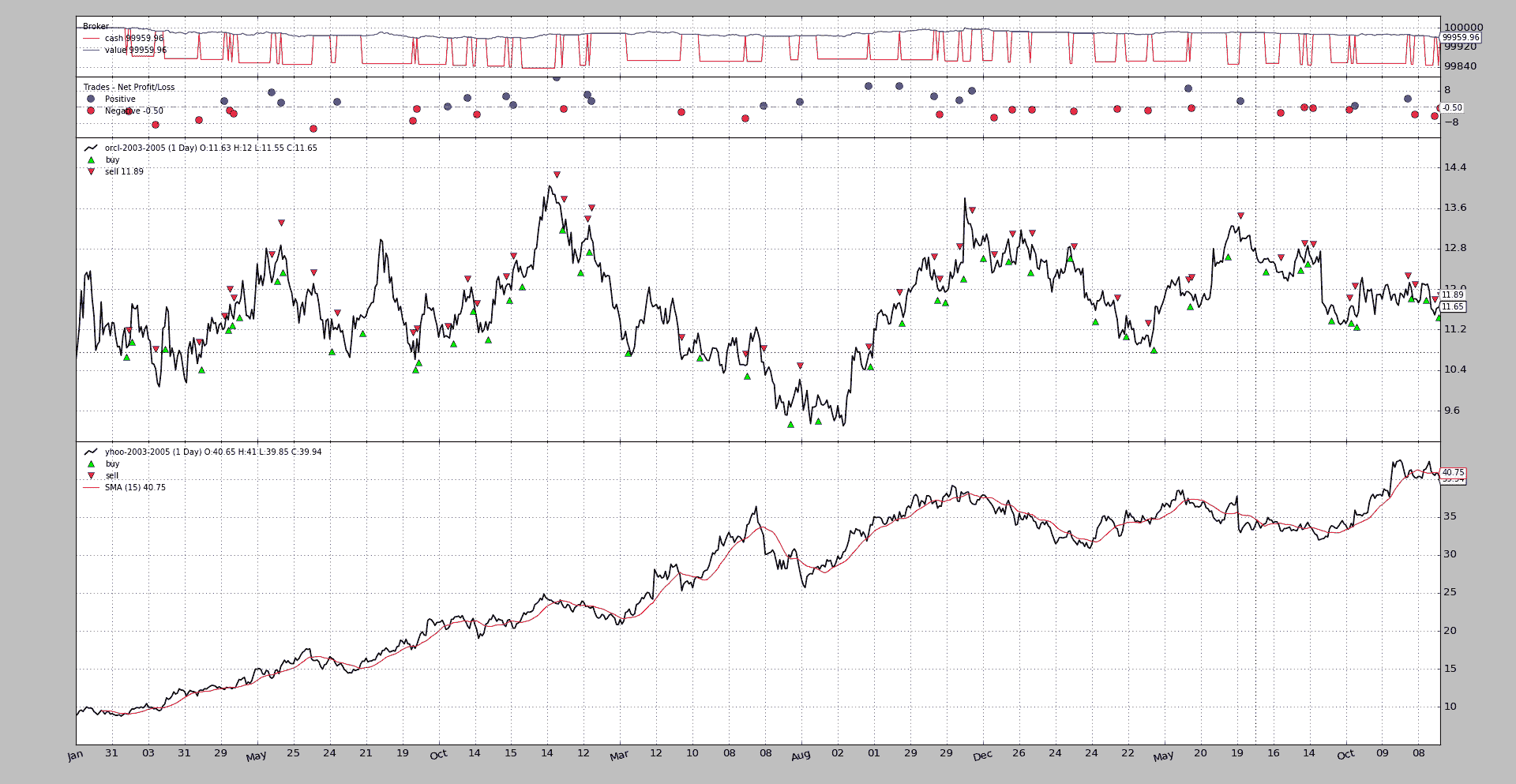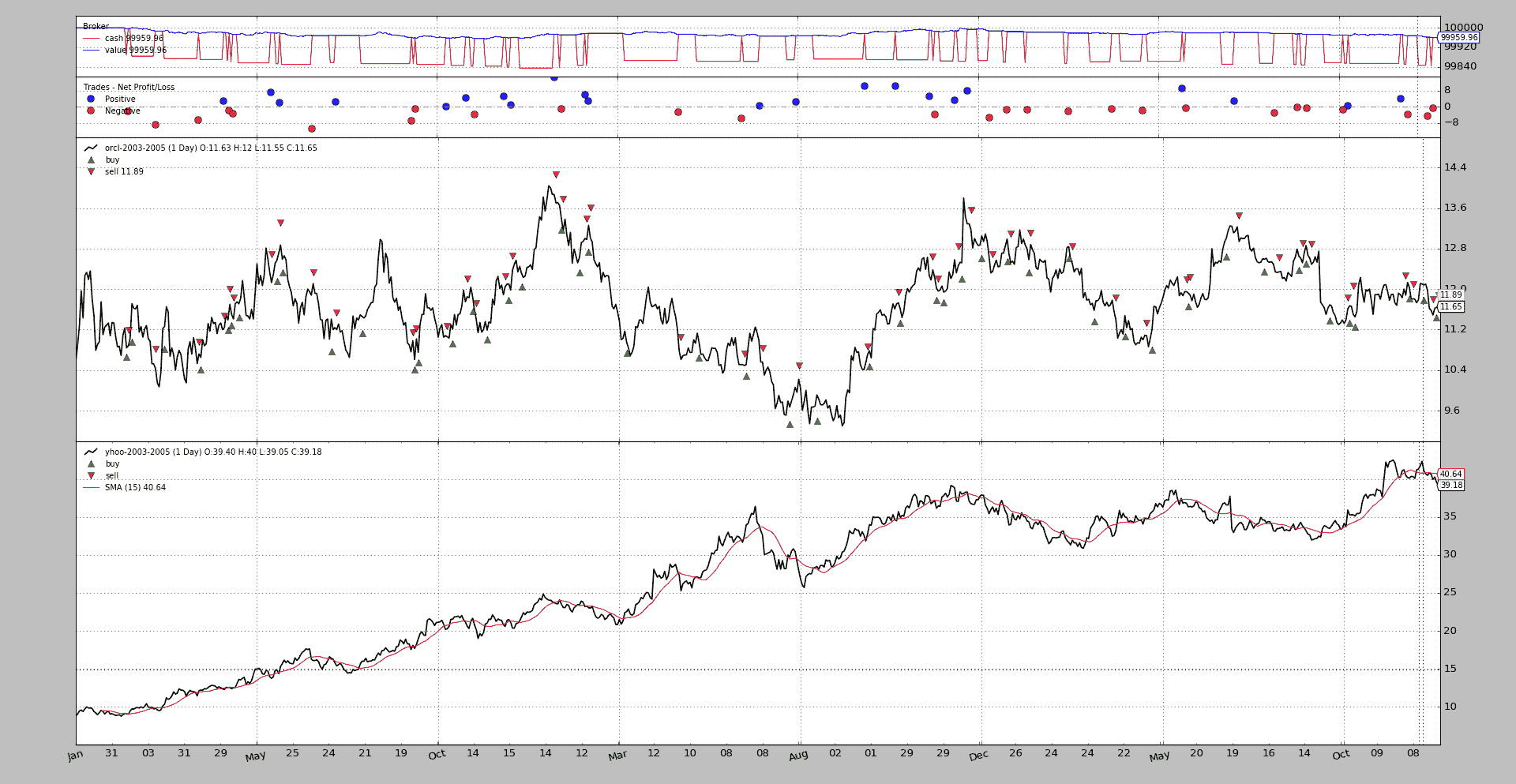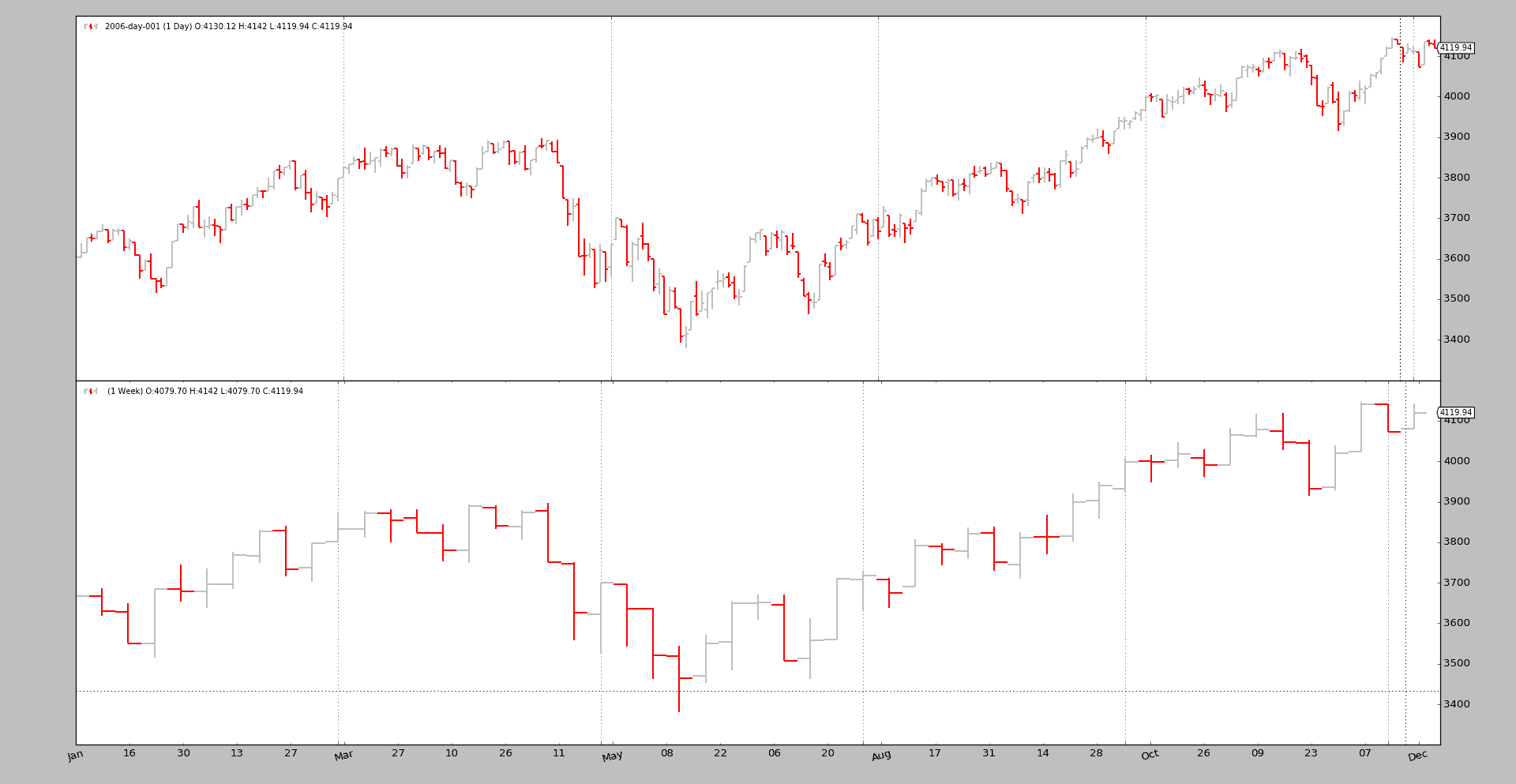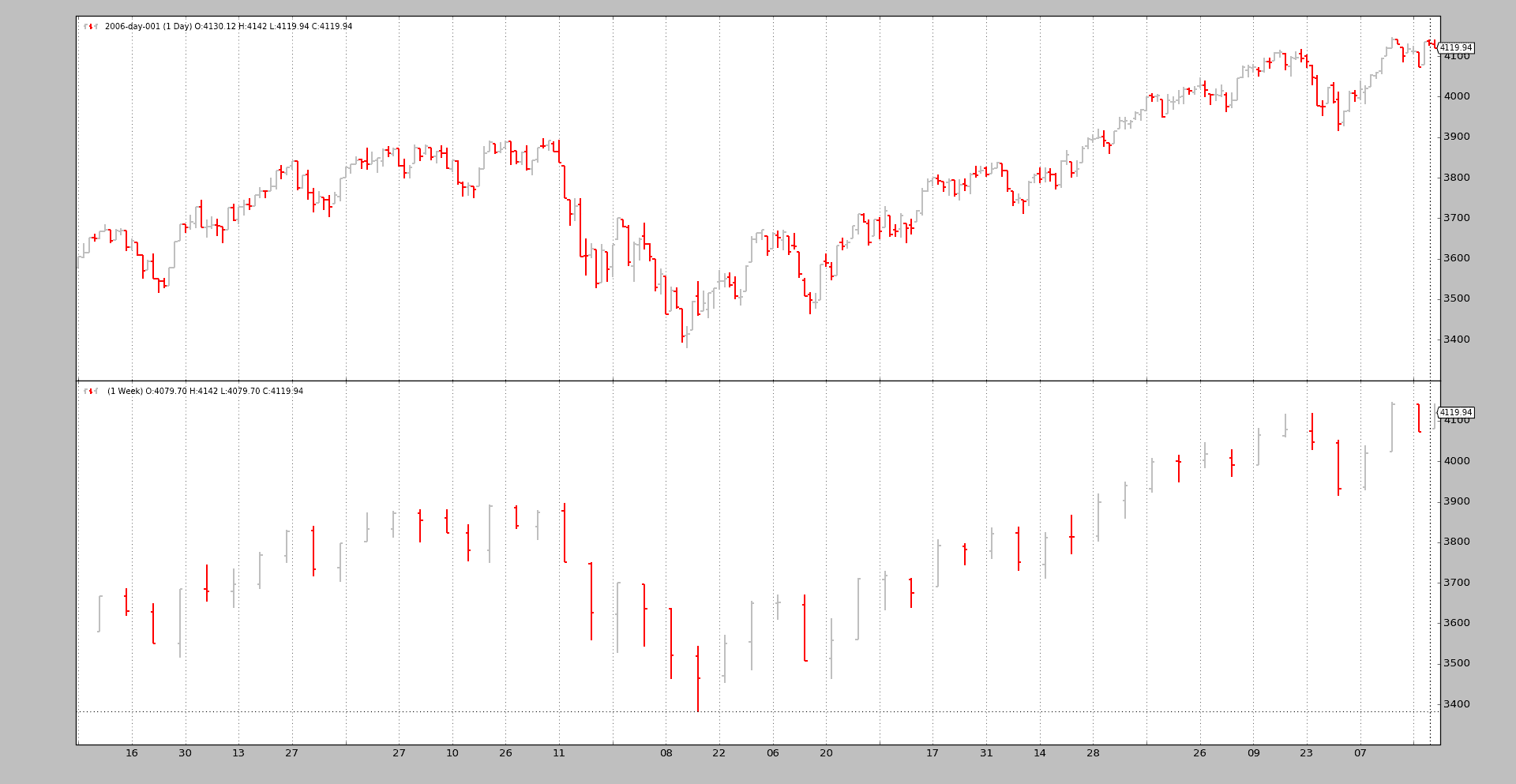数据同步返工
原文: https://www.backtrader.com/blog/posts/2016-09-17-data-synchronization/data-synchronization/
在最新版本中,次要编号已从 8 移到 9,以表示可能会产生某些行为影响的更改,即使考虑到兼容性。
在 1.9.0.99 版中,使用日期时间同步多个数据的整个机制已经重新设计(对于下一个和一次模式)。
笔记
所有标准测试用例都从nosetests得到了很好的确认,但复杂的用例可能会发现未涵盖的角落用例。
之前的行为在罚单【39】【76】【115】和【129】中进行了讨论,这是反对旧行为的基础。
现在,检查传入价格的日期时间时间戳,以对齐数据并交付新内容(首先是旧条)。好处:
-
现在可以使用非时间对齐的数据。
-
在 live Feed 中,由于自动重新同步,行为得到改善
让我们回忆一下,旧的行为使用系统中引入的 1st数据作为时间同步的主数据,没有其他数据可以更快。系统中引入数据的顺序现在不起作用。
部分返工处理了绘图问题,天真地认为所有数据最终都具有相同的长度,这是拥有时间主机的结果。新的绘图代码允许不同长度的数据。
笔记
通过使用以下命令,旧行为仍然可用:
cerebro = bt.Cerebro(oldsync=True)
或:
cerebro.run(oldsync=True)
看一个样本
multidata-strategy样本已作为multidata-strategy-unaligned样本的基础(在同一文件夹中)。两个数据样本已手动更改,以删除一些条形图。两者都有756条,并在两个不同的时间点被限制为753
-
2004 年底,2005 年初
YHOO -
ORCL的 2005 年底
一如往常,一次处决抵得上千言万语。
首先是旧的行为
执行:
$ ./multidata-strategy-unaligned.py --oldsync --plot
从输出来看,最重要的部分就在末尾:
...
Self len: 753
Data0 len: 753
Data1 len: 750
Data0 len == Data1 len: False
Data0 dt: 2005-12-27 23:59:59
Data1 dt: 2005-12-27 23:59:59
...
注意:
-
策略的长度为
753 -
1st数据(时间主机)也有
753 -
2nd数据(时间从机)有
750
从输出中看不明显,但YHOO文件包含的数据高达2005-12-30,系统未对其进行处理。
视觉图表
新行为
执行:
$ ./multidata-strategy-unaligned.py --plot
从输出来看,最重要的部分就在末尾:
...
Self len: 756
Data0 len: 753
Data1 len: 753
Data0 len == Data1 len: True
Data0 dt: 2005-12-27 23:59:59
Data1 dt: 2005-12-30 23:59:59
...
行为明显改善:
-
策略的长度为
756,每个数据都指向完整的753数据点。 -
由于删除的数据点不重叠,因此策略最终比数据长
3个单位。 -
2005-12-30已经到达data1(它是data0删除的数据点之一),所以所有数据都已经处理到最后
视觉图表
虽然这些图表没有显示出重大的差异,但它们在幕后实际上是不同的。
另一张支票
对于感兴趣的用户,data-multitimeframe样本已经更新,也支持--oldsync参数。因为现在正在绘制不同长度的数据,所以较大时间范围的视觉效果更好。
使用新的同步模型执行
使用旧的同步模型执行
样本使用
$ ./multidata-strategy-unaligned.py --help
usage: multidata-strategy-unaligned.py [-h] [--data0 DATA0] [--data1 DATA1]
[--fromdate FROMDATE] [--todate TODATE]
[--period PERIOD] [--cash CASH]
[--runnext] [--nopreload] [--oldsync]
[--commperc COMMPERC] [--stake STAKE]
[--plot] [--numfigs NUMFIGS]
MultiData Strategy
optional arguments:
-h, --help show this help message and exit
--data0 DATA0, -d0 DATA0
1st data into the system
--data1 DATA1, -d1 DATA1
2nd data into the system
--fromdate FROMDATE, -f FROMDATE
Starting date in YYYY-MM-DD format
--todate TODATE, -t TODATE
Starting date in YYYY-MM-DD format
--period PERIOD Period to apply to the Simple Moving Average
--cash CASH Starting Cash
--runnext Use next by next instead of runonce
--nopreload Do not preload the data
--oldsync Use old data synchronization method
--commperc COMMPERC Percentage commission (0.005 is 0.5%
--stake STAKE Stake to apply in each operation
--plot, -p Plot the read data
--numfigs NUMFIGS, -n NUMFIGS
Plot using numfigs figures
示例代码
from __future__ import (absolute_import, division, print_function,
unicode_literals)
import argparse
import datetime
# The above could be sent to an independent module
import backtrader as bt
import backtrader.feeds as btfeeds
import backtrader.indicators as btind
class MultiDataStrategy(bt.Strategy):
'''
This strategy operates on 2 datas. The expectation is that the 2 datas are
correlated and the 2nd data is used to generate signals on the 1st
- Buy/Sell Operationss will be executed on the 1st data
- The signals are generated using a Simple Moving Average on the 2nd data
when the close price crosses upwwards/downwards
The strategy is a long-only strategy
'''
params = dict(
period=15,
stake=10,
printout=True,
)
def log(self, txt, dt=None):
if self.p.printout:
dt = dt or self.data.datetime[0]
dt = bt.num2date(dt)
print('%s, %s' % (dt.isoformat(), txt))
def notify_order(self, order):
if order.status in [bt.Order.Submitted, bt.Order.Accepted]:
return # Await further notifications
if order.status == order.Completed:
if order.isbuy():
buytxt = 'BUY COMPLETE, %.2f' % order.executed.price
self.log(buytxt, order.executed.dt)
else:
selltxt = 'SELL COMPLETE, %.2f' % order.executed.price
self.log(selltxt, order.executed.dt)
elif order.status in [order.Expired, order.Canceled, order.Margin]:
self.log('%s ,' % order.Status[order.status])
pass # Simply log
# Allow new orders
self.orderid = None
def __init__(self):
# To control operation entries
self.orderid = None
# Create SMA on 2nd data
sma = btind.MovAv.SMA(self.data1, period=self.p.period)
# Create a CrossOver Signal from close an moving average
self.signal = btind.CrossOver(self.data1.close, sma)
def next(self):
if self.orderid:
return # if an order is active, no new orders are allowed
if self.p.printout:
print('Self len:', len(self))
print('Data0 len:', len(self.data0))
print('Data1 len:', len(self.data1))
print('Data0 len == Data1 len:',
len(self.data0) == len(self.data1))
print('Data0 dt:', self.data0.datetime.datetime())
print('Data1 dt:', self.data1.datetime.datetime())
if not self.position: # not yet in market
if self.signal > 0.0: # cross upwards
self.log('BUY CREATE , %.2f' % self.data1.close[0])
self.buy(size=self.p.stake)
else: # in the market
if self.signal < 0.0: # crosss downwards
self.log('SELL CREATE , %.2f' % self.data1.close[0])
self.sell(size=self.p.stake)
def stop(self):
print('==================================================')
print('Starting Value - %.2f' % self.broker.startingcash)
print('Ending Value - %.2f' % self.broker.getvalue())
print('==================================================')
def runstrategy():
args = parse_args()
# Create a cerebro
cerebro = bt.Cerebro()
# Get the dates from the args
fromdate = datetime.datetime.strptime(args.fromdate, '%Y-%m-%d')
todate = datetime.datetime.strptime(args.todate, '%Y-%m-%d')
# Create the 1st data
data0 = btfeeds.YahooFinanceCSVData(
dataname=args.data0,
fromdate=fromdate,
todate=todate)
# Add the 1st data to cerebro
cerebro.adddata(data0)
# Create the 2nd data
data1 = btfeeds.YahooFinanceCSVData(
dataname=args.data1,
fromdate=fromdate,
todate=todate)
# Add the 2nd data to cerebro
cerebro.adddata(data1)
# Add the strategy
cerebro.addstrategy(MultiDataStrategy,
period=args.period,
stake=args.stake)
# Add the commission - only stocks like a for each operation
cerebro.broker.setcash(args.cash)
# Add the commission - only stocks like a for each operation
cerebro.broker.setcommission(commission=args.commperc)
# And run it
cerebro.run(runonce=not args.runnext,
preload=not args.nopreload,
oldsync=args.oldsync)
# Plot if requested
if args.plot:
cerebro.plot(numfigs=args.numfigs, volume=False, zdown=False)
def parse_args():
parser = argparse.ArgumentParser(description='MultiData Strategy')
parser.add_argument('--data0', '-d0',
default='../../datas/orcl-2003-2005.txt',
help='1st data into the system')
parser.add_argument('--data1', '-d1',
default='../../datas/yhoo-2003-2005.txt',
help='2nd data into the system')
parser.add_argument('--fromdate', '-f',
default='2003-01-01',
help='Starting date in YYYY-MM-DD format')
parser.add_argument('--todate', '-t',
default='2005-12-31',
help='Starting date in YYYY-MM-DD format')
parser.add_argument('--period', default=15, type=int,
help='Period to apply to the Simple Moving Average')
parser.add_argument('--cash', default=100000, type=int,
help='Starting Cash')
parser.add_argument('--runnext', action='store_true',
help='Use next by next instead of runonce')
parser.add_argument('--nopreload', action='store_true',
help='Do not preload the data')
parser.add_argument('--oldsync', action='store_true',
help='Use old data synchronization method')
parser.add_argument('--commperc', default=0.005, type=float,
help='Percentage commission (0.005 is 0.5%%')
parser.add_argument('--stake', default=10, type=int,
help='Stake to apply in each operation')
parser.add_argument('--plot', '-p', action='store_true',
help='Plot the read data')
parser.add_argument('--numfigs', '-n', default=1,
help='Plot using numfigs figures')
return parser.parse_args()
if __name__ == '__main__':
runstrategy()





